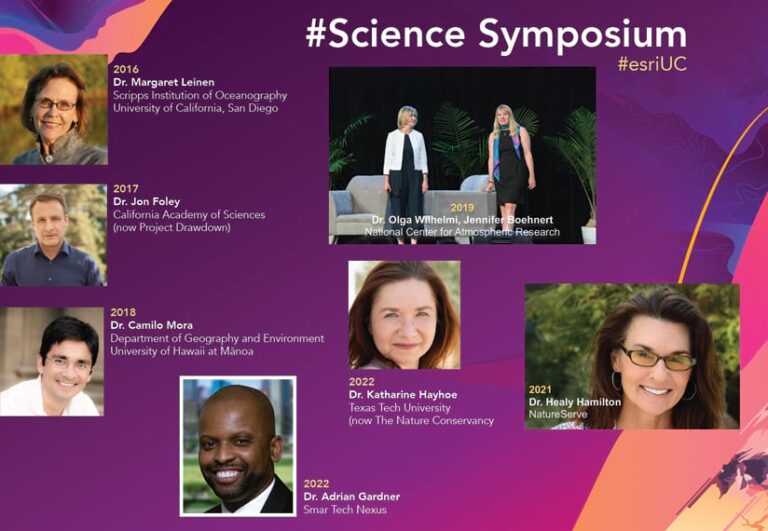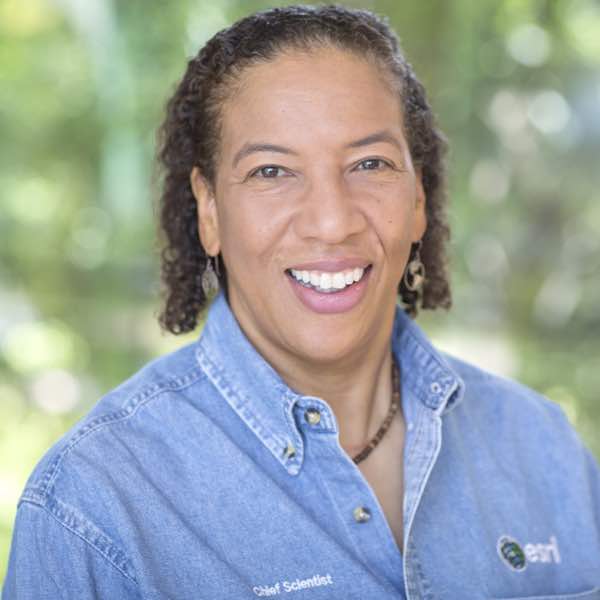Esri has always embraced its mandate to help solve the world’s biggest problems by using GIS software and services—an endeavor that fosters sustainability and resilience along the way. Succeeding in this requires a very broad view of science, one that recognizes the value and rigor of both the physical and social sciences, as well as the digital humanities. It also entails engaging in reliable, verifiable methods of scientific investigation and sharing the results broadly, all with the aim of increasing people’s understanding of the world.
Some years ago, it became evident that a subset of attendees at the Esri User Conference (Esri UC) could benefit from discussions that went beyond traditional geography and GIS and delved into disciplines such as agriculture science, climate science, conservation biology, ecology, forestry, geology, health sciences, hydrology, ocean science, and various social sciences. The idea emerged that it might be beneficial to put on a special, science-focused event at the Esri UC, and the Esri Science Symposium was born.
Founded by yours truly in 2015—with critical input and support from University of California, Santa Barbara, professor emeritus of geography Michael Goodchild—the Esri Science Symposium affirms Esri’s commitment to supporting scientists who are expanding fundamental understanding in many scientific fields by developing innovative GIS tools. The aim of the gathering is to engage with Esri UC attendees who are interested in science and enlighten them on how the pressing issues of today—such as climate change and sustainability—intersect with visualization, geodesign, and the growth of geospatial technology. The symposium also salutes the work of product and solution engineers and industry managers at Esri who are actively involved in scientific research and organizations and publish papers in scientific journals and books.

One of the symposium’s biggest benefits is the networking and community building that happens among scientists. Before, this typically occurred throughout the week of the Esri UC at disparate paper sessions and special interest group meetings, in demonstration theaters, and at technical workshops. Now, the 1,000 or so Esri UC participants—among tens of thousands of attendees—who are academic or government scientists have a home of their own, of sorts, within the larger conference. And the popularity of the symposium keeps growing. In 2015, organizers expected around 30 people to attend a special science reception at the Esri UC, yet more than 300 showed up! In 2016, when a formal registration system was established for the inaugural Esri Science Symposium, that number swelled to 650 attendees.
For that first symposium, Dr. Margaret Leinen, director of the Scripps Institution of Oceanography at the University of California, San Diego, delivered the keynote speech. She talked eloquently about what it takes to understand and protect the planet and people. She discussed the use of innovative data arrays and statistical modeling to better comprehend the impacts of climate change around the globe and the regional interconnectivity of changes in sea surface temperatures, drought, and increase in fire events throughout Southern California.
The following year, Dr. Jonathan Foley—who was then the executive director of the California Academy of Sciences and is now executive director of the climate change solution nonprofit Project Drawdown—challenged the audience to improve the world’s condition by communicating scientific ideas in ways that focus on hope instead of fear, solutions rather than problems, and stories over straight data. And in 2018, Dr. Camilo Mora of the Department of Geography and Environment at the University of Hawai’i at Mānoa delivered a compelling keynote about what he consistently sees as some of the most important climate change issues, including the dangers of deadly heat waves.
The original approach for all three of these symposia was to have a prominent, geospatially informed scientist (rather than someone who specializes in GIS) speak about a broad societal issue and then have a panel of GIScience experts respond to the keynote, sharing how GIS could help solve the problem. Some panelists also discussed how to implement the keynote speaker’s vision for the future from an information technology, informatics, and/or GIS perspective. A brief Q&A session ensued, followed by a networking reception with drinks and delicious appetizers to close out the day.
But the event is always evolving. Adjustments from 2018 to the present have included removing the reaction panel from the program to yield more time for audience participation and networking, and the deliberate decision to invite more women scientists to give the keynote presentation. Starting in 2019 with the publication of the first of three GIS for Science books from Esri Press, every Science Symposium attendee has received a free, advance copy of that year’s volume in ebook form before its public release in the fall. In fact, the prerelease of these special books—which highlight how scientists use GIS to understand the way Earth works, how humans have changed Earth’s appearance and function, and how different ways of looking at Earth through observation and measurement are vital—has been timed each year to match the opening of the Esri Science Symposium. Even though the book series ended with volume 3 last year, symposium attendees will continue to receive a complimentary copy of that book.
Turnout at this 2.5-hour Esri UC session has grown to nearly 800 in-person attendees (to match the capacity of the San Diego Convention Center ballroom in which it is held) and as many as 3,000 online participants during the pandemic years of 2020 and 2021. Feedback about the Esri Science Symposium has been consistently and overwhelmingly positive. This is thanks to the quality of the keynote speeches and the value participants garner from their interactions with one another, given that this is a unique event—not a paper session, not a technical workshop, not a special interest group meeting, and not a typical Esri UC party.
The 2022 Esri Science Symposium will take a marked turn toward the social sciences. Dr. Adrian Gardner, founder and CEO of SmarTech Nexus, a data-driven community engagement nonprofit, will speak about the work his organization does on social determinants of public health and food security, as well as the access urban residents have and don’t have to health services, such as vaccination centers—all with an eye toward racial equity. More specifically, he will discuss how location intelligence and faith-based organizations are essential components for improving service delivery in hard-to-reach, underserved, and at-risk communities.
This year’s event will take place on Tuesday, July 12, from 4:00 p.m. to 6:30 p.m. (Pacific time), in Ballroom 20 D of the San Diego Convention Center. Everyone who is registered for the Esri UC is eligible to attend the symposium in person, and badges will be scanned at the door. The event will not be livestreamed virtually.
Please, won’t you come join us?


